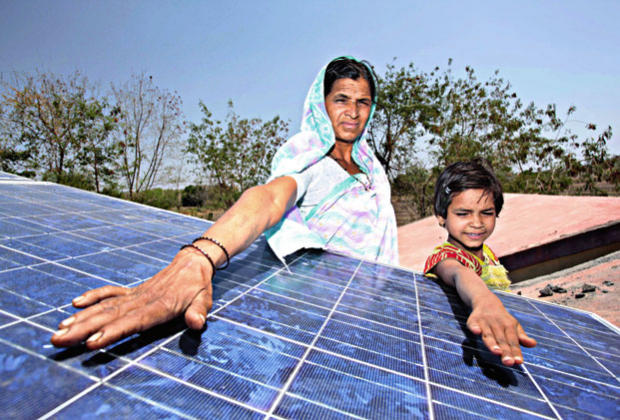The following is the 4th of the articles l am sending documenting that the transition from fossil fuels to a green energy economy is not some vague future pipe dream but is happening NOW. Personally coming from a career in the automotive business I am labeling these article as “Buckle Up” because the road ahead is changing fast. It could be bumpy but it will also be exciting. So, buckle up!
I love feedback so please feel free to comment.
In this article you’ll see that India is recognizing the value of large scale solar energy projects for economic, political, employment and environmental reasons. The future is not in the future but here now. In the last couple of years solar energy costs have dropped dramatically and are continuing to drop. Solar is now about the same price as coal and natural gas. And sunshine is free, abundant, domestically available and doesn’t tear up our landscapes or our roads and bridges to obtain and transport.
India Readies Big Move Into Solar Energy
Proposed 4,000-Megawatt Plant in Rajasthan Would Power Homes in the Northwest
By BIMAN MUKHERJI

Workers gather soil in a salt field on Sambhar Lake in Rajasthan, site of a proposed solar-power station.Biman Mukherji
SAMBHAR, India—Here on the shores of a salt-water lake in the desert state of Rajasthan, India hopes to build a solar-power station that eventually will dwarf the world’s largest such plants under construction today.
When the proposed project is finished in seven years, government officials say, carpets of photovoltaic solar panels will turn the site into a potential supplier of 4,000 megawatts of electricity capable of delivering power to millions of homes across the northwest. The site currently is used by a state-owned salt producer.
Three federal ministries have backed the plan. The cabinet of Prime Minister Manmohan Singh is expected to make a final decision on whether to go ahead with the project this month.
“The government wants to make a statement with this project that solar can be a solution to the power needs of the country,” said Tarun Kapoor, joint secretary of the Ministry of New and Renewable Energy.
India’s imports of oil, gas and coal have ballooned in recent years, contributing to a chronic trade deficit that has shaken international confidence in its future. To reduce that import dependence and become greener, in 2010 India launched the Jawaharlal Nehru National Solar Mission, a bid to raise solar-generating capacity to 20,000 megawatts by 2022. That would bring solar to about 5% of its power mix from less than 1% today, according to government projections. It also has proposed boosting its nuclear power capacity and domestic production of fossil fuels.
Since the launch of the solar mission, the country’s capacity has risen to roughly 2,000 megawatts from just 18, according to government figures.
“Developing countries have been slow in embracing solar energy since the focus primarily has been on ensuring energy security” through conventional sources, said Amol Kotwal, Associate Director, Energy & Power Systems Practice, at consulting firm Frost & Sullivan in Bangalore. “India, though a late starter in solar, has shown a tremendous growth in the last three years.”
Solar power in India, as elsewhere in the world, has been getting cheaper as the price of photovoltaic cells has fallen and solar modules have become more efficient, industry experts say.
In the last three years, solar-generation costs here have dropped to about 7-8 rupees (US 11.2-12.8 cents) a kilowatt hour from around 18 rupees (28.8 cents)/kwh three years ago, said Amit Kumar, director of the Energy and Resources Institute, a New Delhi research group.
Mr. Kapoor of the renewable energy ministry said he believes the proposed Sambhar plant, operating on such a large scale, eventually would be able to produce power for around 5 rupees (8 cents)/kwh.
Power from imported coal and domestically-produced natural gas currently costs around 4.5 rupees (7.2 cents)/kwh, Mr. Kumar said.
The Sambhar project would cover some 20,000 acres in this arid region 60 miles west of Rajasthan’s capital, Jaipur. Officials said about 5,000 workers will be needed to build and maintain the facility during the first phase of construction. As many as 20,000 could be employed there eventually. Mr. Tandon said Plant owners hope to hire as many people as they can from the local community, said R.K. Tandon, managing director of Hindustan Salts, which owns the salt-producing operation and through its subsidiary, Sambhar Salts Ltd., is part of a consortium of Indian companies backing the project.
“Our biggest advantage is that we have such a huge pool of land available that is blessed with sunshine almost throughout the year,” said R.K. Tandon, managing director of Hindustan Salts, which owns the salt-producing operation and through its subsidiary, Sambhar Salts Ltd., is part of a consortium of Indian companies backing the project.
Officials said about 5,000 workers will be needed to build and maintain it during the first phase of construction, and as many as 20,000 could be employed there eventually. Mr. Tandon said Plant owners hope to hire as many people as they can from the local community, said R.K. Tandon, managing director of Hindustan Salts, which owns the salt-producing operation and through its subsidiary, Sambhar Salts Ltd., is part of a consortium of Indian companies backing the project.
That’s a welcome prospect for some villagers whose families for generations have been loading trays of salty soil from Sambhar Lake’s shores onto rickety railway cars for processing in a nearby factory.
“I have been working at the salt fields here for the last ten years and my father worked here before me because there is hardly anything else to do,” said Moolchand Malik, 33, as he took a break from gathering the ash-gray soil. “We hope this power project comes through so that we can have better jobs” in the plant, he said.
A big undertaking by any measure, Sambhar in time would be able to produce far more power than the world’s largest solar projects currently under construction. That includes, among others, the Topaz Solar Farm, which is being developed by First Solar Inc.FSLR -1.10% in California and is expected to have a capacity of 550 megawatts when it’s completed in 2015.
Sambhar is expected to be built in four phases over a seven-year span.Each of its four phases of construction, over a seven-year period, will cost about 70 billion rupees (about US$1.1 billion) and will add 1,000 megwatts of capacity, officials said.
Consortium partners in phase one, which is scheduled to be completed in last three years, include state-owned giants Bharat Heavy Electricals Ltd. 500103.BY -3.
Projects this big can bump up against India’s bureaucratic bottlenecks, which have held back everything from road construction to the building of subways and the modernization of ports., and managing any undertaking of such scope is inherently complicated.
But backers played down the likelihood of delays, noting the project it already has the support of the ministries of power, renewable energy and heavy industries.
“It will take significant effort to coordinate between multiple stakeholders…, ensure appropriate technologies and begin to generate power at encouraging efficiencies and build confidence that such an ambitious project can come to fruition,” said Rajeev Palakshappa, a research associate with the Council on Energy, Environment and Water, a New Delhi-based think tank.
But backers played down the likelihood of delays, noting the project already has the support of the ministries of power, renewable energy and heavy industries.
Write to Biman Mukherji at biman.mukherji@wsj.com


